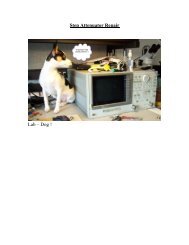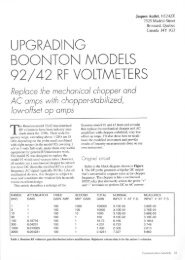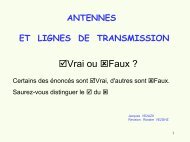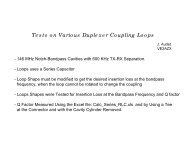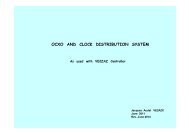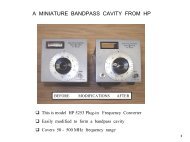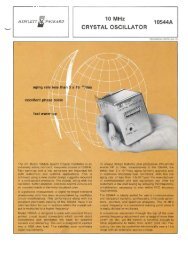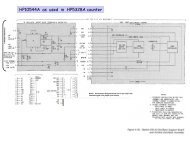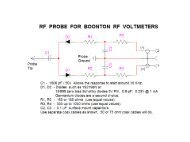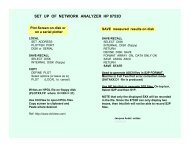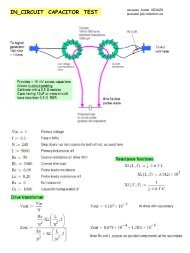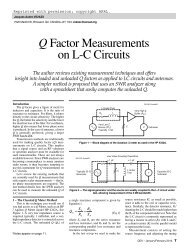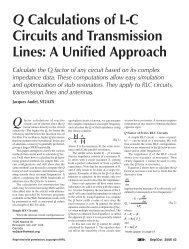repeater sensitivity / de-sense tests - The Repeater Builder's ...
repeater sensitivity / de-sense tests - The Repeater Builder's ...
repeater sensitivity / de-sense tests - The Repeater Builder's ...
You also want an ePaper? Increase the reach of your titles
YUMPU automatically turns print PDFs into web optimized ePapers that Google loves.
REPEATER SENSITIVITY / DE-SENSE TESTS<br />
TESTING RX SENSITIVITY DEGRADATION CAUSED BY:<br />
- ANTENNA NOISE PICK-UP<br />
- TX SIGNAL FEEDING BACK INTO RX<br />
BUILDING A USEFUL SAMPLER – WITH MEASURED RESPONSE<br />
GE MASTER II FRONT END HELICAL FILTER RESPONSE<br />
GE MASTER II PREAMPLIFIER NOISE FIGURE TESTS<br />
Jacques Au<strong>de</strong>t<br />
VE2AZX<br />
Web: ve2azx.net<br />
Jan 2012<br />
1
SUMMARY OF SENSITIVITY / DE-SENSE TESTS<br />
TX OFF<br />
TX ON<br />
Margin<br />
-13 dBm<br />
-20 dBm<br />
Maximum TX feedthru, with duplexer<br />
Maximum TX feedthru, no duplexer<br />
page 5<br />
-30 dBm<br />
-35 dBm<br />
Operating TX feedthru from duplexer<br />
RX port + antenna noise / RF pickup<br />
Operating TX feedthru from duplexer<br />
RX port, with duplexer into dummy load<br />
As measured with<br />
a broadband voltmeter<br />
As measured on<br />
Master II with<br />
preamp<br />
-122 to -119 dBm<br />
-124 dBm<br />
Degradation caused by<br />
antenna noise, page 3<br />
Sig. Gen alone<br />
Effective<br />
<strong>sensitivity</strong><br />
May be higher<br />
Degradation caused by duplexer<br />
feedthru + antenna noise, page 4<br />
Degradation caused by<br />
duplexer feedthru only, page 4<br />
Sig. Gen alone, TX into dummy load<br />
2
TESTING RX SENSITIVITY DEGRADATION CAUSED BY:<br />
ANTENNA NOISE PICK-UP<br />
50 Ω<br />
SIGNAL<br />
GEN<br />
Sampling<br />
port<br />
Set at RX freq.<br />
<strong>The</strong> sampler is used<br />
backwards, to inject<br />
a signal with minimum<br />
disturbance<br />
TRU<br />
SAMPLER<br />
TRU<br />
<strong>Repeater</strong><br />
RX<br />
Antenna<br />
RX<br />
Duplexer<br />
TX<br />
TX is OFF<br />
Adjust Sig Gen to check <strong>sensitivity</strong> with 50 Ω term connected.<br />
Repeat <strong>sensitivity</strong> test with Antenna connected (Connect to duplexer RX port)<br />
With the antenna, the <strong>sensitivity</strong> is <strong>de</strong>gra<strong>de</strong>d by the antenna noise present. Note the reduction.<br />
On Master II: measured 2 to 5 dB reduction with 2m antenna at QTH<br />
<strong>The</strong> preamp is good enough even with 4.7 dB noise figure !<br />
3
TESTING RX SENSITIVITY DEGRADATION CAUSED BY:<br />
TX SIGNAL FEEDING BACK INTO RX<br />
SIGNAL<br />
GEN<br />
Sampling<br />
port<br />
Set at RX freq.<br />
<strong>The</strong> sampler is used<br />
backwards, to inject<br />
a signal with minimum<br />
disturbance<br />
TRU<br />
SAMPLER<br />
TRU<br />
<strong>Repeater</strong><br />
RX<br />
RX<br />
Duplexer<br />
Dummy load / Antenna<br />
TX<br />
<strong>Repeater</strong><br />
TX<br />
- Set up equipment as shown.<br />
- With TX OFF, set Sig Gen just above the squelch trigger level.<br />
-Turn ON TX with duplexer connected to dummy load: <strong>The</strong> <strong>repeater</strong> RX<br />
<strong>sensitivity</strong> should remain the same. (1 or 2 dB <strong>de</strong>-<strong>sense</strong> is OK).<br />
- Repeat above test with the antenna connected. This shows the combined<br />
effect of the TX <strong>de</strong>-<strong>sense</strong> and the antenna noise.<br />
4
TESTING TX MAXIMUM FEEDTHRU INTO RX<br />
– Check without / with notch filter<br />
40 dB min<br />
1 dB steps<br />
Variable<br />
attenuator<br />
TRU<br />
SIGNAL<br />
GEN<br />
Sampling<br />
port<br />
SAMPLER<br />
Set at RX freq.<br />
TRU<br />
<strong>Repeater</strong><br />
RX<br />
<strong>The</strong> sampler is used<br />
backwards, to inject<br />
a signal with minimum<br />
disturbance<br />
Notch Filter<br />
at RX freq.<br />
Hi-Power<br />
attenuator<br />
30 – 40 dB<br />
<strong>Repeater</strong><br />
TX<br />
Set up equipment as shown.<br />
With TX OFF, set Sig Gen 2 - 5 dB above the squelch trigger level. (I used 3 dB).<br />
Set Variable atten to max atten. Turn ON TX: <strong>The</strong> <strong>repeater</strong> RX <strong>sensitivity</strong> should remain the same.<br />
Decrease attenuation in 1 dB steps until the RX squelch turns off the received carrier + noise.<br />
Measure TX power at the sampler output. This is the worst case RX overload point. (-20 dBm on Master II)<br />
With a duplexer, the RX overload point should be higher since filtering of the TX phase noise occurs.<br />
(Measured –13 dBm on Master II, with a 27 dB notch at the RX freq. and ad<strong>de</strong>d between the Hi-Power<br />
atten and Variable attenuator. <strong>The</strong> same value was obtained with a low noise signal generator).<br />
With a duplexer, the RX overload point should be compared to the TX power measured at the RX port<br />
of the duplexer. (Approx – 30 dBm). This shows a good margin.<br />
5
SAMPLER DESIGN and SIMULATIONS<br />
port<br />
1 2<br />
SAMPLER<br />
TRU<br />
TRU<br />
3<br />
Sampling<br />
port<br />
6
SAMPLER SCHEMATIC<br />
0.5 dB<br />
-25 dB<br />
NOTE: Max power IN/OUT<br />
is 4 Watts, with 1:1 SWR<br />
7
SAMPLER PICTURES<br />
Adjustable<br />
capacitor<br />
Optimizes S11<br />
@ 2 GHz<br />
8
SAMPLER PICTURES<br />
Adjustable capacitor before sol<strong>de</strong>ring<br />
Note: Only required on<br />
wi<strong>de</strong>band 2 GHz version<br />
Omit if sampler is only used at VHF<br />
9
Sampler S11<br />
10
Sampler S33<br />
11
Sampler S31<br />
12
0.<br />
Sampler S21<br />
13
Master-II<br />
Helicoidal filter<br />
Frequency response<br />
14
Master-II<br />
VHF preamp<br />
Frequency response<br />
Approx Q factor<br />
of resonators:<br />
33.7 and 9.0<br />
3 MHz<br />
15
MASTER II VHF Preamp<br />
Noise Figure Tests<br />
SA set at 3 MHz BW<br />
(This is the BW used by<br />
the Spectrum Analyzer<br />
to measure noise)<br />
3 MHz measurement BW<br />
yields too low gain since<br />
the gain is not constant<br />
over 3 MHz as shown<br />
on page 3<br />
Ref: http://ve2azx.net/technical/NoiseFigMeasure.xls<br />
16
MASTER II VHF Preamp<br />
Noise Figure Tests<br />
SA at 1 MHz BW<br />
Now yields correct gain !<br />
But Noise Figure<br />
is still poor !<br />
Probably caused by the<br />
loss in preamp BP filters<br />
17
25 dB<br />
SAMPLER<br />
DC - 2 GHz<br />
0.5 dB<br />
Sampler Label<br />
18



